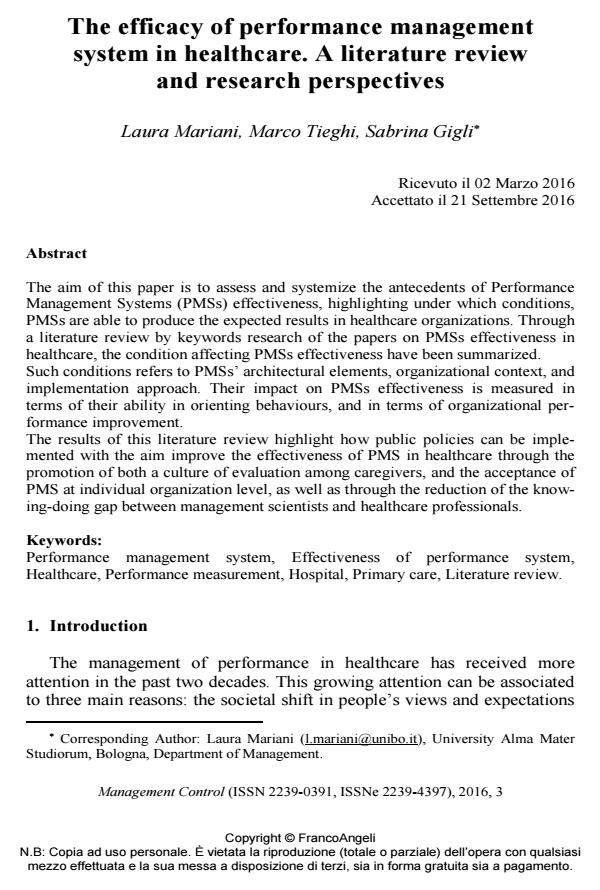The efficacy of performance management system in healthcare. A literature review and research perspectives
Titolo Rivista MANAGEMENT CONTROL
Autori/Curatori Laura Mariani, Marco Tieghi, Sabrina Gigli
Anno di pubblicazione 2016 Fascicolo 2016/3
Lingua Inglese Numero pagine 20 P. 97-116 Dimensione file 429 KB
DOI 10.3280/MACO2016-003006
Il DOI è il codice a barre della proprietà intellettuale: per saperne di più
clicca qui
Qui sotto puoi vedere in anteprima la prima pagina di questo articolo.
Se questo articolo ti interessa, lo puoi acquistare (e scaricare in formato pdf) seguendo le facili indicazioni per acquistare il download credit. Acquista Download Credits per scaricare questo Articolo in formato PDF

FrancoAngeli è membro della Publishers International Linking Association, Inc (PILA)associazione indipendente e non profit per facilitare (attraverso i servizi tecnologici implementati da CrossRef.org) l’accesso degli studiosi ai contenuti digitali nelle pubblicazioni professionali e scientifiche
The aim of this paper is to assess and systemize the antecedents of Performance Management Systems (PMSs) effectiveness, highlighting under which conditions, PMSs are able to produce the expected results in healthcare organizations. Through a literature review by keywords research of the papers on PMSs effectiveness in healthcare, the condition affecting PMSs effectiveness have been summarized. Such conditions refers to PMSs’ architectural elements, organizational context, and implementation approach. Their impact on PMSs effectiveness is measured in terms of their ability in orienting behaviours, and in terms of organizational performance improvement. The results of this literature review highlight how public policies can be implemented with the aim improve the effectiveness of PMS in healthcare through the promotion of both a culture of evaluation among caregivers, and the acceptance of PMS at individual organization level, as well as through the reduction of the knowing-doing gap between management scientists and healthcare professionals.
Parole chiave:Performance management system, Effectiveness of performance system, Healthcare, Performance measurement, Hospital, Primary care, Literature review.
- Accountability, Ethics and Sustainability of Organizations Camilla Falivena, Gabriele Palozzi, pp.133 (ISBN:978-3-030-31192-6)
- Integrating Green Care Initiatives into Conventional Health Systems: Which Governance Dimensions Can Guide This Process? Alessandra Rigo, Elena Pisani, Laura Secco, in International Journal of Environmental Research and Public Health /2025 pp.202
DOI: 10.3390/ijerph22020202 - Il reporting per segmenti nei settori del trasporto pubblico locale e della cura della salute. Esperienze a confronto Domenico Nicolò, Giuseppe Valenza, in MANAGEMENT CONTROL 1/2020 pp.35
DOI: 10.3280/MACO2020-001003 - The clinical risk management. A case study Antonio Fusco, Grazia Dicuonzo, Vittorio Dell’Atti, Nii Amoo, in MANAGEMENT CONTROL 3/2017 pp.31
DOI: 10.3280/MACO2017-003003 - Performance reporting in the healthcare sector: evidence from Italian healthcare organisations Natalia Aversano, Diana Ferullo, Giuseppe Nicolò, Nadia Ardito, in International Journal of Productivity and Performance Management /2024 pp.1117
DOI: 10.1108/IJPPM-07-2022-0341 - Pratiche di controllo di gestione nel contesto sanitario italiano: i cambiamenti in atto nel Sistema Sociosanitario Lombardo Gaia Bassani, Cristiana Cattaneo, in MANAGEMENT CONTROL 3/2017 pp.11
DOI: 10.3280/MACO2017-003002 - L'introduzione di un sistema di prezzi di trasferimento. Il caso dell'Azienda Ospedaliero-Universitaria Pisana Luca Del Bene, Antonello De Vito, Carlo Milli, Fabio Guarracino, in MANAGEMENT CONTROL 2/2018 pp.35
DOI: 10.3280/MACO2018-002003
Laura Mariani, Marco Tieghi, Sabrina Gigli, The efficacy of performance management system in healthcare. A literature review and research perspectives in "MANAGEMENT CONTROL" 3/2016, pp 97-116, DOI: 10.3280/MACO2016-003006